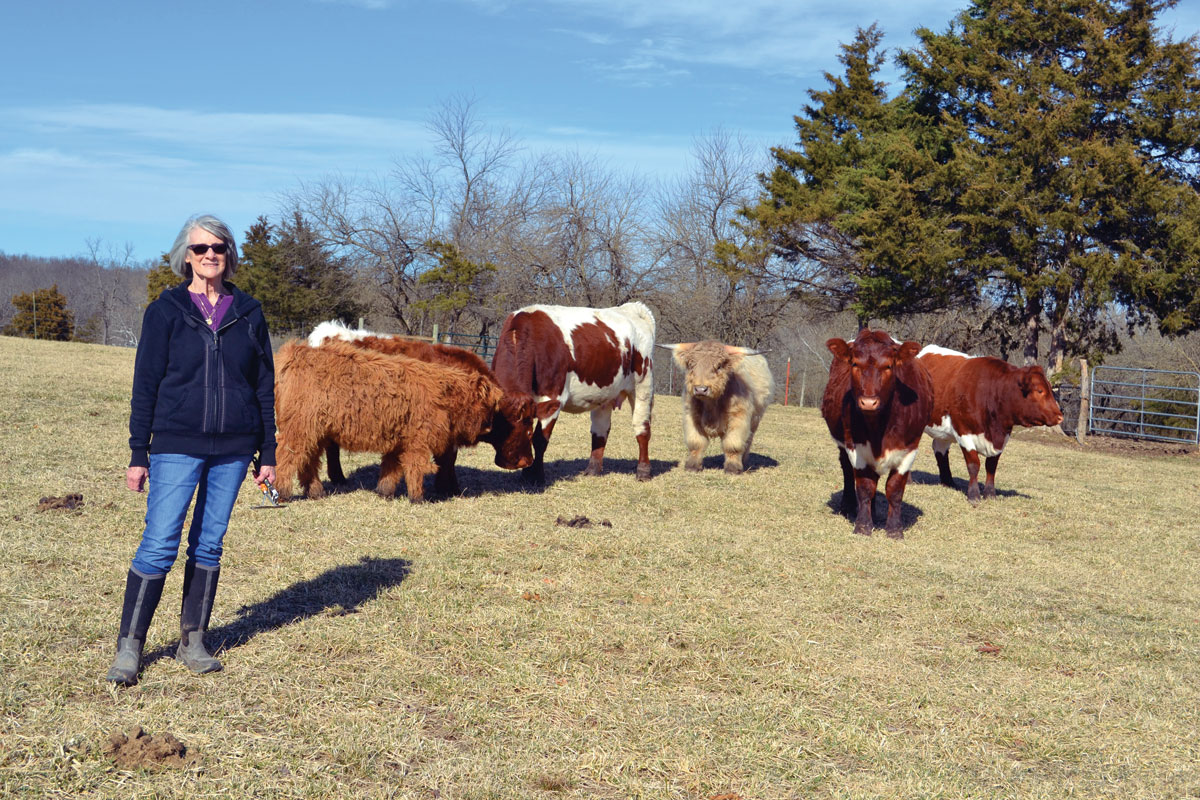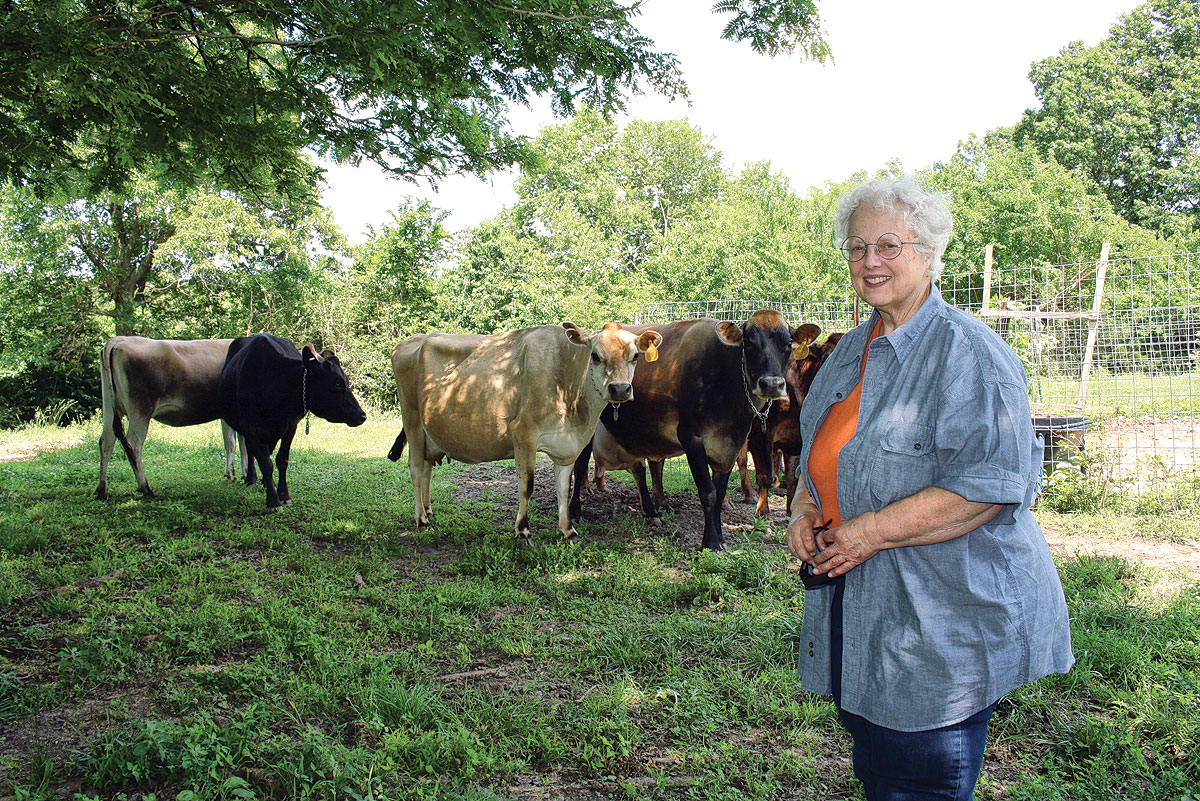
Cedar Creek Farm in Hickory County, Mo., is working to develop its own distinct herd
Tracee Riley of rural Hickory County, is raising Scottish Highland and Pinzgauer cattle at Cedar Creek Farm on 64 acres outside of Preston, Mo.
Along with her husband, Roger, a lab technician for Timkens, working in product development, they currently have 20 head and are crossing the two European breeds.
“Both breeds have several similar characteristics,” Tracee shared while tramping through a muddy field on a warmer than usual Ozarks afternoon. “They are good mothers, easy calvers, and have great longevity, especially the Highland cows.”
According to the American Pinzgauer Association, the Austrian breed is one of the oldest in the world. When crossed with breeds like Highlands, they are known for increased milk production, weaning and yearling weights. Highland cattle are also considered a Heritage Breed, dating from the sixth century. The harsh conditions of its original home country, the Scottish Highlands, created a natural selection process which continues to show through in the 21st century breed. They are known to be hardy foragers and for improving pastures. Because they’re genetics are distinct from other breeds, they make for a highly-productive cross.
“Neither breed is that popular in this area,” Tracee said. “Both are docile breeds and adaptable to our Ozarks climate extremes, able to tolerate the heat. Of course, the Highlands with their thick hides and longer hair are more economical to feed in the winter, requiring less feed to maintain body temp. Their meat is lower in cholesterol and higher in protein due to less fat. Their beef is considered amongst the most tender and is right up there with Angus, in terms of good taste and quality.”
The cross, Tracee said, is a new venture for the couple at their Cedar Creek Farm.
“We’re just getting started,” she added. “The Highlands mature at a slower rate so we’re looking for a faster growth rate with the cross-breeding. We calve in the spring and the fall. Our first cross calves were born last spring, weighing 90 pounds versus the usual 60-plus pounds for Highland calves. Our cattle are primarily grass-fed but we supplement with Purina feeds during breeding, calving, weaning and show season.
“The suckling calves have free access to calf creep. We also ensure they have plenty of loose minerals and salt licks. We prefer our steers to be grain-finished so we finish them out the last 90 to 120 days on a custom blend of rolled corn, oats, soy hull pellets, molasses and BP balancer.”
Tracee, who is retired military, grew up on a farm in northwest Missouri, near Tarkio, where her family had commercial cattle and row crops.
“I was an Aircrew Survival Equipmentman (Parachute Rigger) in the military and made one jump in school. A lot of people enjoy sky diving but I landed safely once and that was enough for me,” she added with a laugh.
After the military, she returned to her agricultural roots. She works with FFA and 4-H youth who show cattle at various regional fairs and shows.
The students come from Missouri schools in Cross Timbers, Wheatland, Linn and even Lebanon.
“I love working with the youth who don’t have an opportunity to show because they don’t live where they can keep animals or their parents are not actively involved in agriculture. One of my kids, upon graduation, took her graduation money and bought three of my heifers to start her own herd,” Tracee said.
The Highland cattle seem to be growing in popularity, and there are many questions asked of Tracee at shows and other events.
“The Highlands are a smaller breed and therefore, easier to handle and less intimidating than many of the larger breeds,” she explained “They draw the crowds at shows and festivals with their furry coats and impressive horns. Most people don’t even realize they are a multi-purpose breed, raised over the years for beef and dairy and even used as draft animals. In this country, they are primarily a beef breed. We like the fact that the Highlands draw people in and then we can talk about and continue to promote both breeds. We show at county fairs, the Ozark Empire Fair, the Missouri State Fair, shows and displays like Farm Fest, Living History Days, and Heritage Days.”
Her Pinagauer’s also turn a few heads.
“The American Pinagauer Association has their national show at the Missouri State Fair,” Tracee said. “Last year my crossbred bull took grand champion and my crossbred heifer took reserve. It was such a rewarding finish to the show season for the kids.”
The Riley’s operation may be small right now but with champion stock, they have plans for the future, and are building their seedstock operation.
“We sell bulls, heifers and steers by private treaty as well as at the upcoming Heartland Highland Auction at the Mid-Missouri Stockyard in April,” Trace said. “And then we’ll see where we go from there.”






